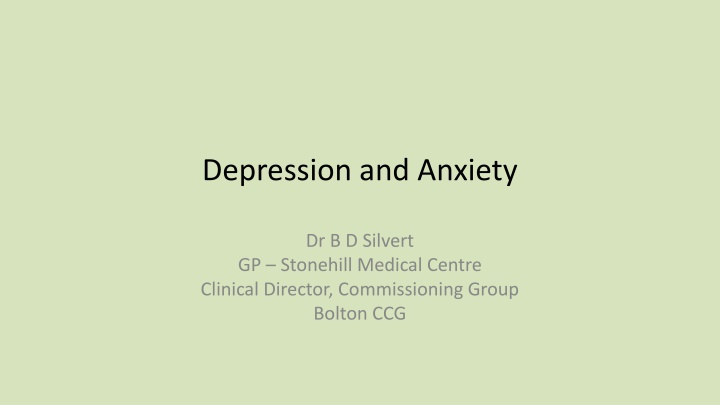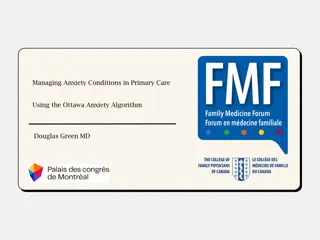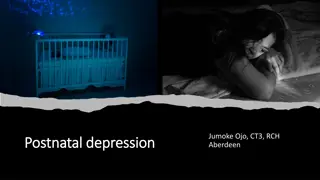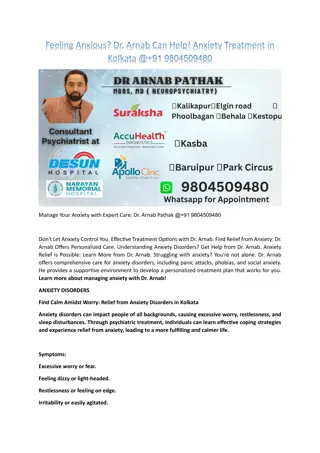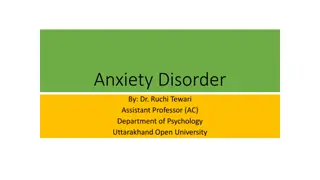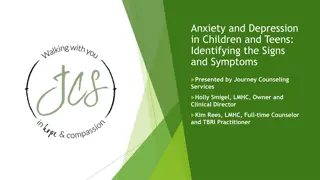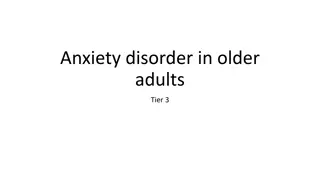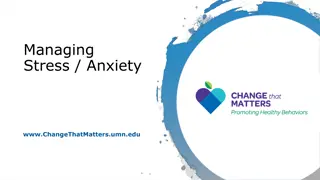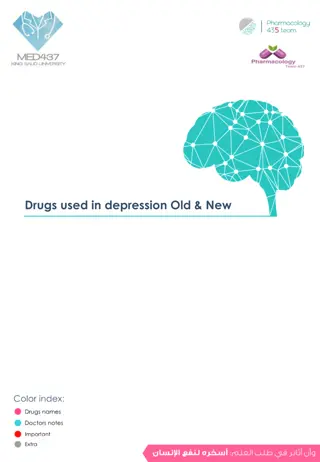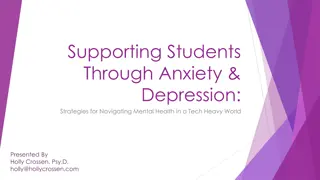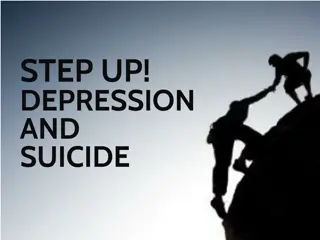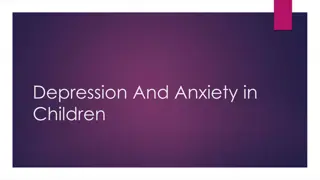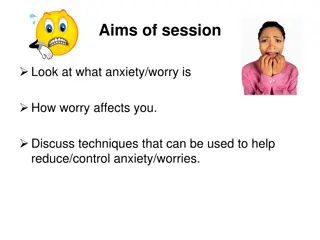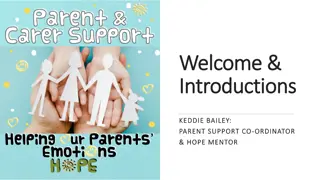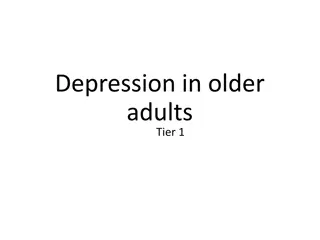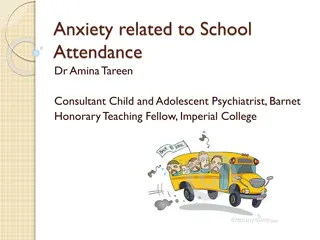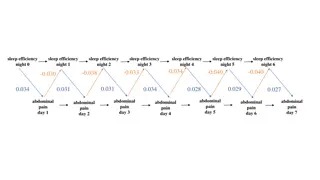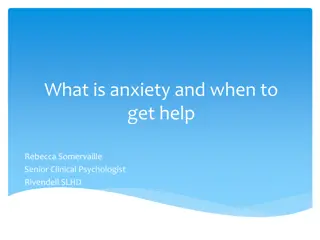Insight into Depression and Anxiety: Causes, Symptoms, and Solutions
Depression and anxiety are common mental health conditions that can impact anyone at any time. Factors like genetics, early life experiences, and stressful events play a role in their development. Recognizing the symptoms, such as anhedonia, sleep disturbances, and suicidal ideation, is crucial for early intervention. Adjustment disorder and post-natal depression are also discussed, shedding light on short-term conditions and specific triggers. Understanding these aspects can help individuals seek appropriate support and treatment for better mental well-being.
Download Presentation

Please find below an Image/Link to download the presentation.
The content on the website is provided AS IS for your information and personal use only. It may not be sold, licensed, or shared on other websites without obtaining consent from the author.If you encounter any issues during the download, it is possible that the publisher has removed the file from their server.
You are allowed to download the files provided on this website for personal or commercial use, subject to the condition that they are used lawfully. All files are the property of their respective owners.
The content on the website is provided AS IS for your information and personal use only. It may not be sold, licensed, or shared on other websites without obtaining consent from the author.
E N D
Presentation Transcript
Depression and Anxiety Dr B D Silvert GP Stonehill Medical Centre Clinical Director, Commissioning Group Bolton CCG
Depression Lifetime incidence 20%. At any time 5-10% are affected. Women twice as likely as men to be affected. Bipolar disorder much less common lifetime risk 1 2%. Men and women equally affected. 22/02/2025 2
Causes not fully understood Genetics or early life experiences may be involved. Stressful life events. Physical illness, medications, recreational drugs. 22/02/2025 3
Symptoms Anhedonia. TATT. Anergia. Sleep disturbance. Anorexia or binge eating. Loss of concentration. Feeling guilty Feeling hopeless, down or depressed Restlessness, tension, anxiety Suicidal ideation. Loss of confidence. Irritability. Avoiding other people. Difficulty making decisions. Feeling useless or inadequate. Loss of libido 22/02/2025 4
PHQ 9 over past two weeks 0-4 none. 5-9 mild. 10-14 moderate. 15-19 mod. Severe. 20-27 severe. Not at all. Several days. More than half the days. Nearly every day. Scores > 10 sensitivity and specificity of 88% 22/02/2025 5
Adjustment disorder Short term condition when an individual has difficulty coping with or adjusting to stress. Now called stress response syndrome (2013). Tends not to involve as many physical and emotional symptoms. Triggers:- Relationship break-up. Job loss or change Death Serious illness personal or loved one. Victim of crime. Accident. Major life change. Living through disaster. 22/02/2025 6
Adjustment disorder Usually begins within 3 months. Rarely lasts longer than 6 months. Reaction to stressor greater than typically expected. May cause problems with ability to function. Sleep, work, study. 22/02/2025 7
Post-natal depression Low mood (baby blues) is common. PND occurs in 10-15% of mothers. Usually develops in first month. Probably hormonal trigger. More common in mothers with previous episodes of depression. History of depression in family members. Stressful life events during pregnancy. Unplanned pregnancy. Poor support at home. Neonatal problems. 22/02/2025 8
Puerperal psychosis One in 500 women. More likely with previous episode of severe mental illness or strong family history of SMI. Mania or depression. Muddled thoughts, delusions, hallucinations. Onset 2 days to 2 weeks. 22/02/2025 9
SAD Symptoms often begin in autumn. Typically most severe Dec, Jan, Feb. Usually improves and disappears spring and summer. Often returns in repetitive pattern. Craving carbohydrates. Effects on hypothalamus Increased melatonin production. Decreased serotonin levels. Disorder of circadian rhythm. 22/02/2025 10
Scenario 1 57 year old male (Peter). Heavy drinker. Unemployed. History of sexual abuse aged 13-15. Poor social conditions. Marriage break-up 6 months ago. Previous suicide attempt 9 months ago. No contact with his grown-up children. Police cautions for violent behaviour. Presents with depressed mood. Plan your actions 22/02/2025 11
Scenario 2 24 year old lady (Julie). Diagnosis of bipolar disorder. Poor social conditions. Imprisoned for theft 9 month sentence. History of self harm (cutting). Victim of domestic violence. Regular cannabis and amphetamine user. Non-drinker. No previous suicide attempts. Working in prison how would you assess the risk? 22/02/2025 12
Suicide 2013 6708 suicides in UK and Ireland. Increasing each year approx. 4%. 55,000 in EU every year. One death by suicide every 2 hours. Leading cause of death among 20-34 in UK. 4x as many men die as a result of suicide. Highest risk men 45-59 (25 per 100,000) More than 70% not contacted health professional in previous year about their feelings. 22/02/2025 13
Risk factors Drug and alcohol misuse. History of trauma or abuse. Unemployment. Social isolation. Poverty. Poor social conditions. Imprisonment. Violence. Family breakdown. Diagnosed mental health condition. Previous attempts. Approx. 15% try again within one year 2% fatal. 22/02/2025 14
Generalised anxiety disorder Worry significantly affects daily life, including job and social life. Worry is extremely stressful and upsetting. Worry about variety of things and tend to be pessimistic. Worry is incontrollable. Occurred nearly every day during previous 6 months. 22/02/2025 15
Psychological symptoms Restlessness Sense of dread. Constant feeling of being on edge. Poor concentration. Irritability. 22/02/2025 16
Somatic symptoms Dizziness, tiredness. Palpitations. Muscle aches and tension. Shaking or trembling. Dry mouth. Excessive sweating. SOB. Abdo. Pain. Nausea. Headache. Paraesthesiae. Insomnia. 22/02/2025 17
GAD 7 over past 2 weeks. Nervous, anxious, on edge. Unable to control or stop worrying. Worrying excessively about different things. Difficulty relaying. Difficulty sitting still due to restlessness. Easily annoyed or irritable. Feeling of impending doom. 0. Not at all 1. Several days 2. More than half the days 3. Nearly every day Score of; 5 mild anxiety 10 moderate anxiety 15 severe anxiety Score > 10 Sensitivity 89% Specificity 82% 22/02/2025 18
PTSD Usually presents during first month. Either constant, severe or fluctuating symptoms. RE-EXPERIENCING Flashbacks, nightmares, repetitive and distressing images. Physical sensations (pain, nausea, trembling). May have constant negative thoughts. AVOIDANCE Avoiding certain people or places. Avoiding talking about experience. Distraction with work or hobbies. Emotional numbing trying not to feel anything at all. Can lead to isolation and withdrawal. 22/02/2025 19
PTSD HYPER-AROUSAL Very anxious. Difficulty relaxing. Constant awareness of threats. Easily startled. Leads to irritability, anger, insomnia, poor concentration. PTSD often accompanied by depression, anxiety, phobias, drug/alcohol misuse. Physical symptoms (headaches, dizziness, chest pain, abdo. pain). CHILDREN Nightmares. Abdo. pain. Bedwetting. 22/02/2025 20
Scenario 3 Annie aged 48. Presents with low back pain, tiredness. Works at Asda as a shelf stacker. Married with two grown-up children. Symptoms started 3 months ago, getting worse. Examination:- No significant findings,. All blood tests normal. Advised to avoid heavy lifting, swim, paracetamol and Ibuprofen as required. Comes back 6 weeks later no better, in fact worse. Difficulty sleeping. Pain all over body and tenderness in many places., What do you do next? 22/02/2025 21
